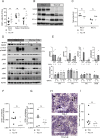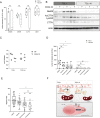The scaffold protein NEDD9 is necessary for leukemia-cell migration and disease progression in a mouse model of chronic lymphocytic leukemia
- PMID: 35523865
- PMCID: PMC9252910
- DOI: 10.1038/s41375-022-01586-1
The scaffold protein NEDD9 is necessary for leukemia-cell migration and disease progression in a mouse model of chronic lymphocytic leukemia
Abstract
The scaffold protein NEDD9 is frequently upregulated and hyperphosphorylated in cancers, and is associated with poor clinical outcome. NEDD9 promotes B-cell adhesion, migration and chemotaxis, pivotal processes for malignant development. We show that global or B-cell-specific deletion of Nedd9 in chronic lymphocytic leukemia (CLL) mouse models delayed CLL development, markedly reduced disease burden and resulted in significant survival benefit. NEDD9 was required for efficient CLL cell homing, chemotaxis, migration and adhesion. In CLL patients, peripheral NEDD9 expression was associated with adhesion and migration signatures as well as leukocyte count. Additionally, CLL lymph nodes frequently expressed high NEDD9 levels, with a subset of patients showing NEDD9 expression enriched in the CLL proliferation centers. Blocking activity of prominent NEDD9 effectors, including AURKA and HDAC6, effectively reduced CLL cell migration and chemotaxis. Collectively, our study provides evidence for a functional role of NEDD9 in CLL pathogenesis that involves intrinsic defects in adhesion, migration and homing.
© 2022. The Author(s).
Conflict of interest statement
All authors declare no competing interests.
Figures






Similar articles
-
NEDD9 regulates actin dynamics through cortactin deacetylation in an AURKA/HDAC6-dependent manner.Mol Cancer Res. 2014 May;12(5):681-93. doi: 10.1158/1541-7786.MCR-13-0654. Epub 2014 Feb 26. Mol Cancer Res. 2014. PMID: 24574519 Free PMC article.
-
Dual Targeting of Mesenchymal and Amoeboid Motility Hinders Metastatic Behavior.Mol Cancer Res. 2017 Jun;15(6):670-682. doi: 10.1158/1541-7786.MCR-16-0411. Epub 2017 Feb 24. Mol Cancer Res. 2017. PMID: 28235899 Free PMC article.
-
NEDD9 stabilizes focal adhesions, increases binding to the extra-cellular matrix and differentially effects 2D versus 3D cell migration.PLoS One. 2012;7(4):e35058. doi: 10.1371/journal.pone.0035058. Epub 2012 Apr 11. PLoS One. 2012. PMID: 22509381 Free PMC article.
-
Preclinical and clinical studies of the NEDD9 scaffold protein in cancer and other diseases.Gene. 2015 Aug 1;567(1):1-11. doi: 10.1016/j.gene.2015.04.086. Epub 2015 May 9. Gene. 2015. PMID: 25967390 Free PMC article. Review.
-
Roles of neural precursor cell expressed, developmentally downregulated 9 in tumor-associated cellular processes (Review).Mol Med Rep. 2015 Nov;12(5):6415-21. doi: 10.3892/mmr.2015.4240. Epub 2015 Aug 24. Mol Med Rep. 2015. PMID: 26324022 Review.
Cited by
-
Macrophages downregulate NEDD9 to counteract S. Typhimurium- mediated FAK-AKT activation and lysosome inhibition.Cell Death Dis. 2025 Jun 12;16(1):445. doi: 10.1038/s41419-025-07634-9. Cell Death Dis. 2025. PMID: 40506423 Free PMC article.
References
Publication types
MeSH terms
Substances
LinkOut - more resources
Full Text Sources
Molecular Biology Databases
Miscellaneous

